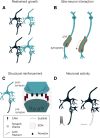Establishment and Maintenance of Neural Circuit Architecture
- PMID: 33568445
- PMCID: PMC7888231
- DOI: 10.1523/JNEUROSCI.1143-20.2020
Establishment and Maintenance of Neural Circuit Architecture
Abstract
The ability to sense the world, process information, and navigate the environment depends on the assembly and continuous function of neural circuits in the brain. Within the past two decades, new technologies have rapidly advanced our understanding of how neural circuits are wired during development and how they are stably maintained, often for years. Electron microscopy reconstructions of model organism connectomes have provided a map of the stereotyped (and variable) connections in the brain; advanced light microscopy techniques have enabled direct observation of the cellular dynamics that underlie circuit construction and maintenance; transcriptomic and proteomic surveys of both developing and mature neurons have provided insights into the molecular and genetic programs governing circuit establishment and maintenance; and advanced genetic techniques have allowed for high-throughput discovery of wiring regulators. These tools have empowered scientists to rapidly generate and test hypotheses about how circuits establish and maintain connectivity. Thus, the set of principles governing circuit formation and maintenance have been expanded. These principles are discussed in this review.
Copyright © 2021 the authors.
Figures




References
Publication types
MeSH terms
Grants and funding
LinkOut - more resources
Full Text Sources
Other Literature Sources
Miscellaneous
